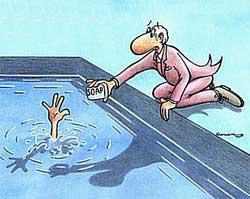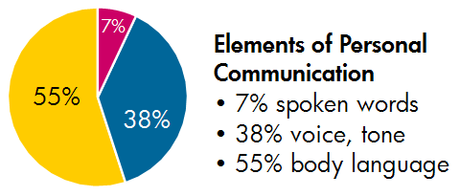
Communication, whether in business or socially is undergoing changes away from face-to-face communication and more and more towards written communication.
This can be seen in everyday communication where e-mail is the stock medium for everyday communication in organisations along with instant messaging, with the increasing use in business of social media such as Twitter, Linked-in, Facebook etc.
People favour written communication as it provides easy tracking in business, facilitating stockage and filing – this is the good side.
On the other hand e-mail communication is fast becoming one of the major causes of stress and frustration in business – featuring among the top 3 causes of time-wasting and stressers in the workplace.
Just to get you thinking about this, consider the following questions:
- How many emails do you receive a day?
- How many of these are addressed directly to you (not where you are on copy of a mail)?
- How many mails do you delete as soon as you receive them?
- How often do you consult your mailbox during the day? (perhaps this should read, “How often do you turn your mail off?”)
- Do you have an alarm or alert, either visual or a sound for the reception of mails?
- How often have you received a mail from somebody you can see in the office?
- How often have you sent a mail to somebody who you can see in the office?
- Have you ever received an aggressive mail?
- Have you ever sent an aggressive mail?
- Have you ever misinterpreted a mail?
- Have you ever sent a mail that was misinterpreted by another person?
Most Human Resource managers will agree that many of the risks “psycho-social” in companies, related to stress stem from bad or inappropriate communication, citing, in many cases the use of email.
That is email – what about social media?
Social media is practically the same, at least in terms of the communication side – it is another form of written communication.
So what are the risks with written communication?
In order to answer that question, let’s have a quick look at successful communication in the broadest of terms.
In essence, successful communication occurs only when the outcome of the communication is equal to the intention that the person communicating the message had when the message was communicated – simple I=O – and this applies to all and any form of communication.
Effective communication occurs when a message is sent, received, and understood as intended
It is a two-party process, requiring willingness, motivation, and discipline on the part of both the message sender and the receiver.
According to studies carried out by Albert Mehrabian at UCLA;
when all three factors – vocal, visual, and word content – are consistent your message has a better change of being received as you intended.
When there is inconsistency between the factors, the listener will accept the nonverbal message as the truthful interpretation 55% of the time.
Mehrabian’s work has formed the backbone and bread and butter for Soft Skills trainers for years, taken as a law, “written-in-stone”.
Now, Mehrabian’s work has been criticised from many angles, but this is not really important here as I prefer to take his model of communication as a basis for heightening awareness of the primacy of process over content, providing a model that can be easily understood and acceptable to most.

Mehrabian states that in a face-to-face communication situation, the message passes through 3 channels :
- VERBAL – representing 7% of the understanding / interpretation
- PARA-LINGUISTIC – 38% composed of sounds, pauses, intonation, register etc.
- NON-VERBAL – 55% including posture, gestures, eye and face movements etc.
So this is in a face-to-face situation, where all variables are used to convey the message.
Over the phone we can also use certain variables to communicate or decode a message:
How many times have you used your hands when giving directions over the telephone, indicating a turning or a bend in the road?
This doesn’t help the receiver, but it definately helps the person giving the directions.
How many times have you been aware that your call was on loudspeaker, with others in the room, even though it may not have been said?
France Telecom used to say, “You can hear a smile over the telephone.”
Which is surely true.
People often stand up and walk around whilst speaking on the telephone, once again it helps the sender of the message in many ways – so, as you can see, the three communication channels are inevitably used when communicating orally in varying degrees.
We may not be able to see the people we are communicating with, but we can definitely hear them.
The problem with written communication
One of the presuppositions in NLP is that, “The meaning of your communication is the reaction it elicits”, which is an interesting point on at least two levels:
1. We are responsible not only for the transmission of our communication but also in the way it is understood and interpreted.
2. Communication involves empathetic dynamics.
How often have you written a message that was misunderstood by the person reading it?
If this has never happened to you, then you probably don’t write many messages.
We can see from Mehrabian’s model, that our message, in written form, now needs to be constructed with only 7% of the elements that are available in oral communication – losing a massive 93% of the variables that aid the communication process.
No wonder there are so many problems and risks with written communication!
You know that we all have that little voice in our heads when writing a message / mail or a letter – it’s the way that we play the scenario that we will then present in print or in writing.
If you are writing a message with an ironic voice then expect it to be decoded and interpreted by the reader as sarcasm or as a reproach.
The key is to cover all bases – reread what you write, imagine the context, culture and situation of your readers.
In one of my training courses I use an example of two people who work together as an activity :
The context is that Jane has been on holiday for a week and Maria wants to send her a message welcoming her back to work.
Maria has been really busy as she was alone in the office and can’t wait for her friend to return both for the company of having a friend in the office and to share the workload.
Maria sends the following message on Friday afternoon to Jane, to welcome her back to work :
Dear JaneAt last you are back from holiday!!!!!There’s lots to do….See youMaria
Jane comes into work early on Monday morning as she knows she will have a lot of mails to sort through, starts her computer up even before she gets her first coffee and sees the message from Maria, which straight away puts her into an angry mood:
- Firstly, I don’t take that much holiday – damned cheek!
- She isn’t happy to see me back, just that her workhorse is back to graft away
- She didn’t even ask how I was nor how my holiday went
- She can’t have been that busy if she has time to send sarcastic mails.
So let’s have a look at the risks of written communication in social media and the way in which we can avoid some of the traps, here I am specifically referring to Twitter, as the Social Medium, although it can also be applied elsewhere.
Tweets are short – 140 characters, so the message needs to be crafted well.
We could argue that the relative brevity of a 140 word message could trigger a certain level of directness, although this is not always the case, have a look at some of the tweeters around you.
If you are selling something or want something, you need to go through the correct procedure of engaging with people; in conversation.
You wouldn’t go up to somebody at a party and shout repeatedly in their faces “I HAVE A SYSTEM FOR GETTING YOU RICH” Listen to me! now would you?
People, unbelievably, do this on twitter, and other forms of social networks – unfortunately.
- Reread your messages before sending them
- If you are intending to be ironic, do so with care and with people that ‘know’ you
- Don’t leech other people’s tweets and timelines
- Always be gracious and courteous – please and thank you cost nothing but are valued highly
- Think about what you can give before asking what you can get
- Always reply to a message / #FF or RT with a return, a reference or a thank you
- If you are using sarcasm or humour, demonstrate this with a hashtag #Joke #JustSaying or an emoticon for a smile etc.

- Don’t go for the hard sell in messages – it just does not work
- Dnt rite as U wd in an SMS it maks ppl H8 U – clear full words are what are needed
- Think before pressing the send button!
- Tweet others in the way you would like to be tweeted (you can read this as ‘treat’ too)
- Be yourself
- Share photos, links, information – it’s about what you bring to the party
- Don’t gatecrash conversations unless you know the people
- Have a personality
- Ask questions and reply to those that provide solutions and answers to you
- Find your own voice
- Fill out your bio and use a photo of you as an avatar – people like connecting with real people
- Enjoy tweeting – it shows when you do
- Be active – remember that you cannot not communicate!
With reference to tip number 20, another presupposition of NLP, it is impossible, in whatever you do to not communicate – you will always communicate something.
If somebody tweets you with a direct question and you do not reply – what message are you communicating to them?
If we use the idea of email, it may be clearer:
You send somebody a mail asking them a question. The person hasn’t answered you for two weeks – what impression does that give you?
Most will say that the person doesn’t consider your question important, that it is not on their priority list or that they are ignoring you.
The person may have inadvertently deleted your mail, although they have, in doing nothing, communicated a strong negative message – hence “You cannot not communicate.”
I am not suggesting that written communication should be avoided, far from that, but rather that communication as a whole needs to be undertaken with care, using the best method or medium at the best time to communicate the message in the best way possible.
What tips would you add to improve written communication or the use of Twitter?Bring something to the party – add a comment with your own feelings or tips…Thank you.
© 2011, ©Active Consultants 2011. All rights reserved. Copying in part or in entirety only permitted by written consent
Republished by Blog Post Promoter

